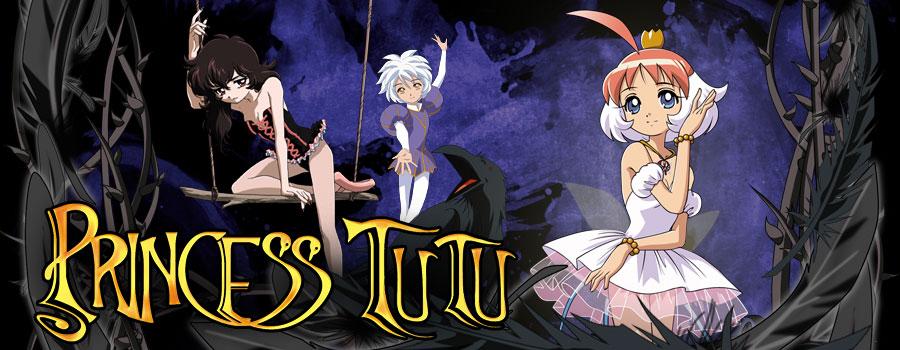 Folcwine P. Pywackett
Folcwine P. Pywackett

| Princess Tutu PROMOTIONAL TRAILER |
Princess Tutu- Swan Ballet |
Princess Tutu AMV - Hold Me Now |
Princess Tutu(2002,2003) (プリンセスチュチュ; Purinsesu Chuchu) 26EP
D: Junichi Sato,
Shogo Koumoto
W: Michiko Yokote
8.311 ANN
8.21 Myanime
8.3 IMDB
Excellent review of Princess Tutu at ANN by Theron Martin, Aug 8th 2006
Excellent fan review at myanimelist.net by Gonzo-lewd Dec 3, 2013
If you should read fan comments about Princess Tutu, there is a common thread in that many ignored this anime because it appeared “girly, or cutsie”. One even suggested the old saying, “Don’t judge an anime [book] by its cover.” Others call it weird, which is hard to understand given an art form that has produced FLCL and Kaiba. How is a ballet dancing Aardvark any different than Fantasia?
We at Pywackett Productions were fully culpable in this response, in that we assumed “Princess Tutu” to be just another little girl’s “Magical Girl” genre anime, and we ignored it for quite some time.
Only after seeing that it constantly appeared on best lists, and carried high numbers, did we begin to pay attention, and went into it rather more like kicking and screaming than joyous anticipation.
Were we wrong! “Mea culpa! Mea culpa!”
Princess Tutu is a fully adult anime, and parents should be warned that there are many very scary scenes, and monsters in this production which would give little children nightmares forever, plus the story is so incredibly complex, that no child could possibly follow what is happening in the story, some adults might not either.
Think of a work of art which combines high, classical ballet and music with a Tex Avery cartoon, a great deal of crazy and very funny slapstick, and bring in scary villains and monsters, and fight for purity and goodness not by fighting, but by the beauty of the dance.
The main protagonist, Duck (あひる Ahiru) (yes, she is a real, live yellow duck (not a spoiler)) falls in love with a Prince because he appears to be sad and unhappy, and wishes she could help him to find his heart, when in comes a strange man, Drosselmeyer from the Nutcracker, who offers her a magical jewel which turns her into (あひる Ahiru) a real little girl. In English, the pun is lost, but in the Japanese Ahiru means Duck, but in this case Ahiru is a name in English and Japanese. Ahiru enrolls in the ballet school where her prince is in study, but she is totally inept at ballet (she is a duck after all), and most of the humor in Tutu surrounds the character of Ahiru and her two friends, Pike and Lilie, who themselves are preciously funny. They constantly engineer situations for Ahiru to fall into because it is just so entertaining for them and for us.
But the humor in Princess Tutu is never taken with respect to its story or to the ballet itself. Every episode is taken from the libretto of a ballet, and the ballet story is then merged with the ongoing story of Princess Tutu being told in the anime (when danger appears which it does often, Ahiru in magical girl style transforms into the beautiful Princess Tutu herself, a majestic creature of style, grace, and beauty who engages with evil, not by conflict or fighting, but by dance, and love!!!). Extreme beauty here is a weapon. And all of this “conflict” is dance to the actual classical ballet orchestral music such as Swan Lake, and all.
If you are a ballet dance fan, you will clearly see the tropes, the conceits, the hackneyed phrases, the stereotypes of the entire corpus of the ballet itself. The artists behind “Princess Tutu” fully understand and love the ballet, that is clear.
All of this is quite charming. But it does not play or stop there, because one of the higher goals and its most intriguing, is that behind all the humor (giant cats as dance teachers whose idol is Meowsky, etc), and the classical music score, there is a story being told about story telling itself, what makes a good story, and how do you tell it.
And then even more complex, this narration or lecture recurses on itself, in a very self-referential story line. And if you have not been paying close attention, you will lose the thread. What? What just happened?
Extremely humorous in extremis, and if you are a ballet fan, you will recognize the romanticism of the ballet itself, captured remarkably well in a crazy and weird and wonderful way.
Highly recommended with no reservations other than “This is not a fairy tale for children, but rather for adults in order to help them remember what it was like to be a child, and to see the world all enchanted and wondrous”.
Wonderous, wonderous indeed!
Princess Tutu has the power to
change you into the child you
once were, provided you do not
let your adult mind bury your
feels. No cynicism or sarcasm
allowed!
 Folcwine P. Pywackett
Folcwine P. Pywackett